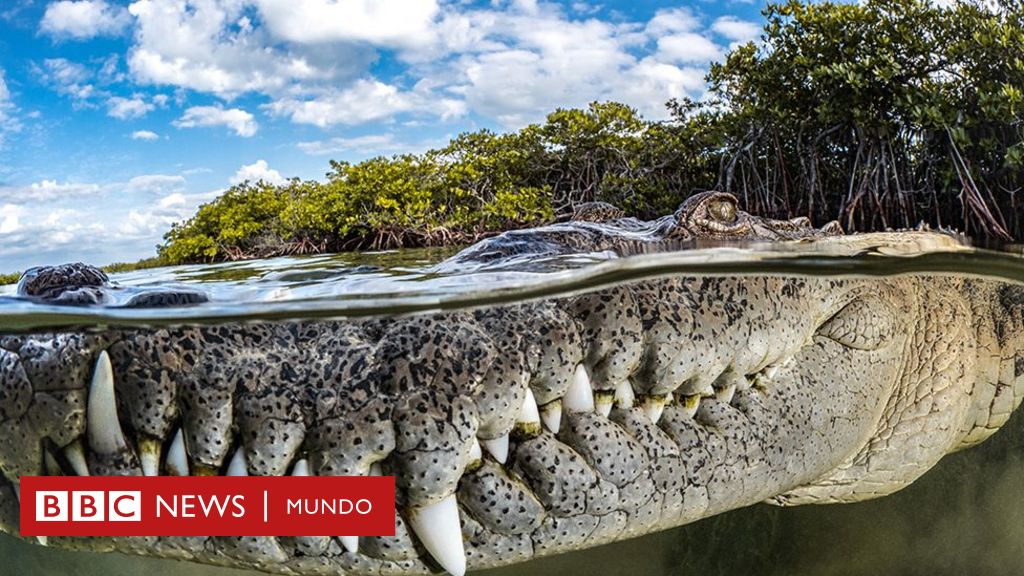- Draft
- BBC News World
Tanya Hoopermans won this year’s Mangrove Photo Awards for her close-up of a crocodile surrounded by mangroves in Cuba’s Jardines de la Reina archipelago.
image source, Tanya Hoopermans
In its eighth year, the competition, organized by the Mangrove Action Programme, aims to showcase the relationships between wildlife, coastal communities and mangrove forests.
Additionally, it seeks to expose The fragility of these unique ecosystemsAbove and below water.
Jardins de la Reina is an archipelago off the coast of Cuba that has been a protected area since 1996.
It is one of the oldest marine ecosystems in the world.
“The healthy population of crocodiles is due to the beautiful condition of the mangroves, and I wanted to capture this gentle giant up close in its natural habitat,” said winner Hoopermans.
“I hope this film succeeds in showing how important it is to protect areas like this.”
Mangroves represent a protection Important against climate change: 4,000 m2 of mangrove forest absorbs as much carbon dioxide as 4,000 m2 of Amazon rainforest.
These forests protect the shorelines from erosion due to frequent storms.
“The Mangrove Photography Awards has become a platform to sensitize people about the wonderful ecological role that mangroves play in all of our lives,” said Judge Thiruthiman Mukherjee.
Another judge, Octavio Aburto, added: “This year’s images captured our imagination… they give us hope and illuminate a positive future for mangrove ecosystems.”
Here is a selection of the winning films from the various categories of the competition.
winner Mangroves and MankindYes: CHoney Growers, Muhammad Mustafiqur Rahman, BangladeshIt is H
image source, Muhammad Mustafiqur Rahman
Honey hunters collect wild honey deep in the mangrove swamps of Bangladesh’s Sundarbans, the world’s largest mangrove forests.
Recent human development and climate crisis in the region, particularly sea level rise, threaten the ecology of the Sundarbans and the way of life of local people.
Mangroves and Humans Runner-up: Living in a White Mangrove, Alex Cao, Vietnam
image source, Alex Gao
A local fisherman casts his net in the white-flowered mangroves (Lumnitzera racemosa) of Bau Ca Cai, a protected area in Vietnam.
This photo was taken in late autumn when the trees had lost their leaves. It highlights the connection between vulnerable communities and nature.
success Belongs to the category Mangroves and Landscape: Dancing Trees Walagiri, Luik Dupuis, Indonesia
image source, Loic Dupuis
The sun rises on the quiet beaches of East Sumba, Indonesia.
Loïc Dupuis wanted to capture the beauty and fragility of this unique wonder.
SecondaryOne of Type Mangroves and Landscapes: Dreaming Life in the Mangroves, Melody Roberts, USA.
image source, Melody Roberts
Sunrise reflection at Florida’s Merritt Island National Wildlife Refuge.
success of Mangroves and Wildlife: take offJayakumar M.N. United Arab States
image source, Jayakumar M.N
A greater flamingo (Phoenicopterus roseus) makes a migratory journey across Asia, often returning to the same coastal wetlands during the winter months.
SecondaryOne Mangroves and Wildlife: AndSpoonbills, Priscilla Foron, Brazil
image source, Priscilla Foron
Guaraqueçaba’s protected mangroves are an important destination for visitors, including this pair of Roseate Spoonbills (Platalea ajaja).
winner Type Mangroves and debGarlic EWater: Blue Crab, Martin Bron, Mexico
image source, Martin Brown
A blue crab (Callinectes sapidus) fishes in a unique transition between fresh and salt water in Mexican cenotes.
While probing through dark flooded caves, the photographer says he spotted the crab standing proudly against the mangrove roots.
SecondaryOne of Mangroves and Submarine: at the border, Jillian E Morris, Bahamas
image source, Jillian E Morris
The photographer says he wanted to show a different side to these young lemon sharks: a social side, a more vulnerable side.
All images are subject to copyright.
Now you can get notifications from BBC World. Download the latest version of our app and activate it so that you never miss our best content.


:quality(85)/cloudfront-us-east-1.images.arcpublishing.com/infobae/BH6NLAQGXJGADFWTENBUV7Z7RQ.jpg)
:quality(85)/cloudfront-us-east-1.images.arcpublishing.com/infobae/3GK63ATFOMFAYNUAQKUL4WUJFM.jpg)

:quality(85)/cloudfront-us-east-1.images.arcpublishing.com/infobae/SJ35ZLSJ5NB4BWVRJPSK74P7AQ.jpg)